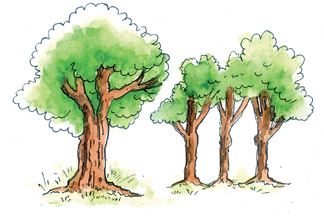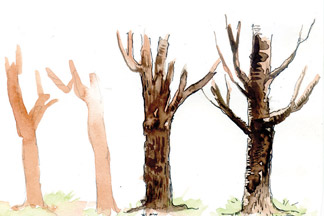
Painting trees in watercolours
Trees are a joy to our eyes and they refresh our spirits. The more
you know about trees the more you want to draw.
It is easy for you to study the details before painting. What
problems do you come across and how can you solve them? What is the
shape of the tree? Is it round, tall or spread out?
|

Figure 1: Impression of trees of various varieties |
How do the leaves look like? Are they fine, broad, pointed or odd
shaped. What does the trunk look like? Smooth, craggy or ringed?
Notice the trees I have painted on Figure 1. On the right (above) you
find a big tree with leaves spread around. Observe the dark shadows that
help to give the tree depth and form.
The first tree shows a pale light wash put on to the trunk and
leaves. A light lemon green is applied as a basic colour and dark green
is applied as a basic colour and dark green is used as a shading.
The big tree shows simple basic colour used as a start for the
beginner. I have used only two colours, green and brown.
To start painting, first apply the light wash (a pale green). After
the first paint has dried go on to the top with a dark colour only the
areas where deep shadows are.
The structure of a tree is formed gradually upwards from its trunk
with branches spread on sides. When drawing a trunk of a tree with
twigs, start from the base of the tree and work up.
|

Figure 2: Varieties of tree trunks with a basic colour wash |
Observe the three small trees painted above. They are typical trees
painted with the basic colour green and painting the leaves in two
washes a light wash and a strong dark colour to show the shading when
the sunlight falls.
The trunks are painted with a light wash brown and in the second
round to show the shading using a dark colour with a thin pointed brush
or a pen with lines drawn as a finished picture of trees.
Painting tree trunks
Figure 2 - Study the tree trunks before painting. The texture, the
shaded dark patches and the bark effects. Notice the two tree trunks I
have painted. First apply a light wash of brown colour over the paper.
Let it dry, go to the next two tree trunks, apply a dark wash and paint
the trunk with vertical strokes of a round brush.
In general, paint the trunk in two different tones, putting the
lightest colour first and adding the strong darker colour while the
first is still damp, keeping in mind where the sunlight falls.
Observe the two tree trunks on the right. The darker stroke is
applied from the left side to show how the sunlight falls and the last
tree completed with thin brush strokes.
The drawing paper should be 250 grams Kent paper with a slight grain
on it, and brushes Nos. 2, 4, 8 and 6. |



